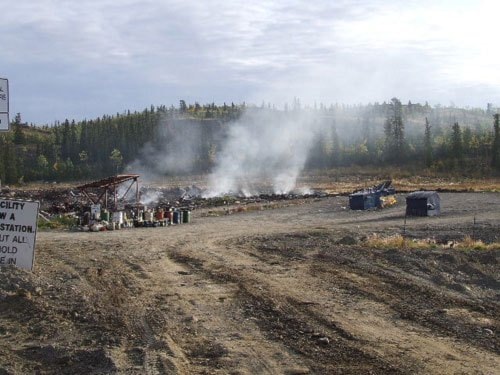If Yukoners are going to keep breathing, they need to stop burning garbage at community dumps, says a report by the Yukon Environmental and Socio-economic Assessment Board.
Pressure to “keep costs low” is forcing privately contracted dump operators to forgo proper waste disposal in favour of setting everything alight, said Doug Davidge, an assessment officer with Environment Canada.
Burning at Yukon dumps generated 23 tonnes of carbon monoxide in 2006, said an April report by the federal agency.
It would cost too much and require too much regulatory change to stop burning, said the Department of Environment.
“A change from burning facilities to landfills can increase operating costs by 10 to 30 times,” said Pat Paslawski with the department.
“It is my opinion that these rationales do not decrease the effect of air emissions on the environment and people,” wrote assessment contributor Russell McDiarnid.
“(Prohibiting) the open burning of solid waste is the only option that I am aware of at this time that will adequately reduce the activity of burning solid waste that is causing a significant adverse effect,” he wrote.
The newly-released assessment only calls for an end to burning. It leaves it to individual dumps to determine how they will move into a nonburning world.
“We’re going to have to look at whether these dumps become transfer stations (to the Whitehorse dump), whether they bury their garbage or whether they look at an increased focus on recycling,” said Raven Recycling spokesperson Lewis Rifkind.
Many community dumps are little more than dirt trenches that are occasionally cleared by low-temperature burns, pouring toxic smoke onto nearby communities.
“The smell settles on the community in the evening,” read a letter from the Ross River Dena Council.
Burning tires, car batteries and plastics release untold pollutants, putting residents at risk of cancers, thyroid diseases, respiratory diseases and birth defects.
“Contaminants from the smoke that settle on the land can compromise the ability of the land to safely support wildlife, or grow food that is safe for human consumption,” read a
submission by Anne Middler, energy co-ordinator for the Yukon Conservation Society.
The assessment recommends that community dumps begin to segregate waste in up to 10 different categories, and that they “investigate ways to divert recyclables.”
It’s going to be difficult and costly to make the switch away from combustion, “but we’re going to have to,” said Rifkind.
“We pump a lot of money into roads and other infrastructure, we’re just going to have to begin recognizing dumps as being something that requires greater costs,” he said.
Air quality concerns have already prompted many communities to make the switch to “burn-free.”
Marsh Lake heavily emphasizes diversion and recycling, and diverts all remaining refuse to the Whitehorse landfill.
Teslin began transferring its waste to the Whitehorse dump three weeks ago.
“Our transfer station has been operating for three weeks now, it works like a charm and we’re quite pleased,” said Wes Wirth, the town’s chief administrative officer.
“It’s responsible stewardship of the land,” he said.
Even if nearby residents aren’t breathing garbage fumes, they may be drinking them, said a submission by the Little Salmon/Carmacks First Nation.
The wells serving the Village of Carmacks were identified as receiving ground water that had flowed from under the Carmacks solid waste facility, according to a hydrological assessment cited by the First Nation.
In the United States, Europe and in almost every Canadian jurisdiction except the Yukon, “landfill liners” are required to prevent contamination of groundwater.
Contact Tristin Hopper at
tristinh@yukon-news.com
